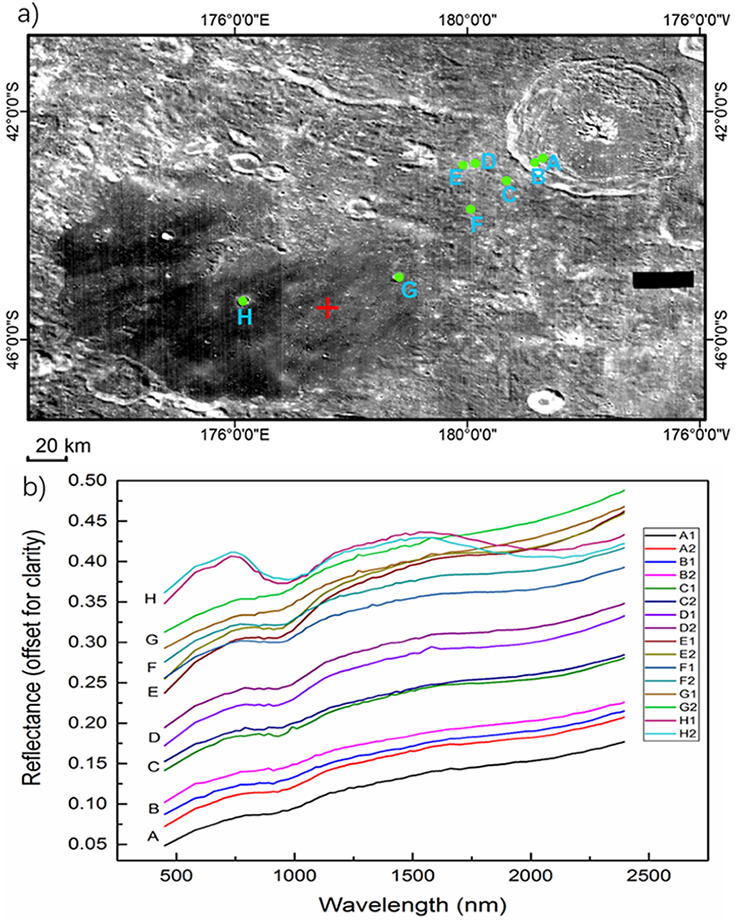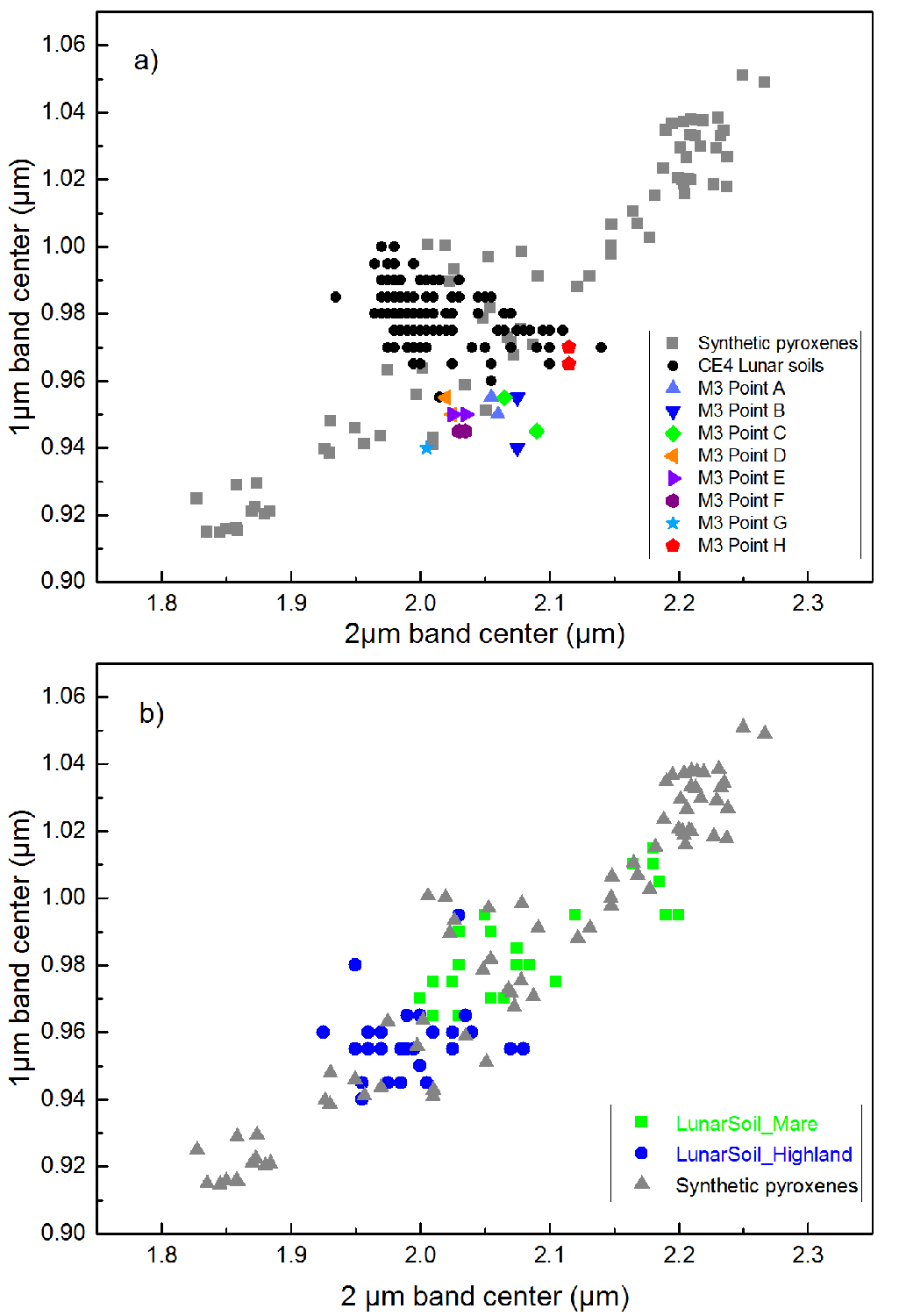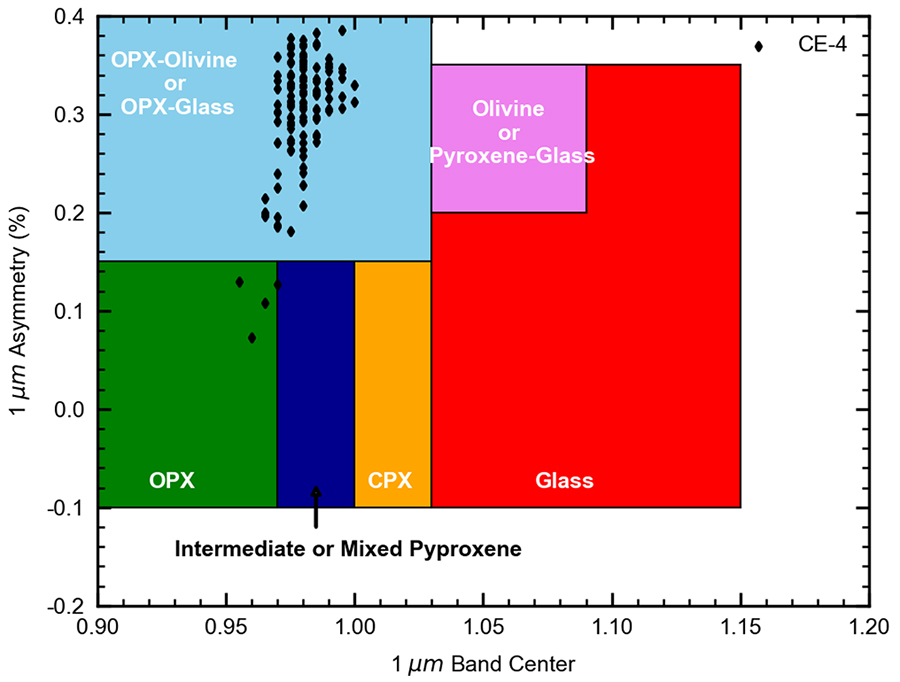The composition and provenance analysis of materials on Chang’E-4 Yutu-2 rover traverse
- Key laboratory of Lunar and Deep Space Exploration, National Astronomical Observatories, Chinese Academy of Sciences
Introduction: The composition and provenance of the materials in South Pole - Aitken Basin (SPA) on southern farside is essential to a number of unresolved science questions relevant to lunar and solar system evolution. The Chang’E-4 mission is the first landed mission to this unexplored region, which provide a unique chance to further constrain the composition and provenance of the lunar interior [1].
There is still controversy about the composition and provenance of materials in Chang 'e-4 landing site [1-7]. The first spectral interpretation results based on the Modified Gaussian Model (MGM) indicate that the landing site is dominated by Low-Ca Pyroxene (LCP) and olivine, which may represent deep-seated materials potentially from the lunar mantle, delivered to the Chang’E-4 landing site by ejecta from the Finsen crater [1-3]. The Hapke model was also used to infer the minerals and glasses’ abundances, which indicated that the landing site is dominated by plagioclase and lesser amount of mafic minerals [4-6]. Other study suggests that the composition of the landing site is still dominated by mare materials, which may be excavated and delivered by Zhinyu Crater [7].
The Yutu-2 rover has been exploring on the lunar surface for more than 60 lunar days, lots of in-situ spectra have been obtained, we will use these in-situ spectral data, orbiting spectral data (M3) and Apollo lunar soils' spectral data in the laboratory to perform a detailed survey on the composition and provenance of materials on the Yutu-2 rover tranverse.
Data and methods: Over 60 lunar days’ data of the Visible and Near-Infrared Imaging Spectrometer (VNIS) on the Yutu-2 lunar rover and the orbiting spectral data of the Moon Mineralogical Mapper (M3) are used. The VNIS data have been processed by dark current subtraction, flat field and instrument temperature correction, radiometric correction, reflectance calculation and spectral smoothing [1], etc. After deducting some data affected by terrain shadows and scattered light, a total of 131 spectral data of lunar soils were selected. For M3 data, the spectral data of some fresh impact craters in the ejecta area of Finsen impact crater and the inner area of Zhinyu impact crater are selected. The location and spectral curves of M3 data are shown in Figure 1. Besides, the spectral data of lunar soils (mare and highland) obtained by Relab are also used.

Figure 1: The location of typical spectra of the selected M3 data. a) the spectral data locations of the fresh impact craters selected along the wall of Finsen impact crater (points A and B) and along the direction of ejecta (points C-G), H point located in side of Zhinyu impact crater. b) Typical spectral curves of the selected M3.
Results and discussion: We firstly calculated the absorption bands of VNIS, M3 and Relab data at ~1μm and ~2μm, the results show that the absorption bands of VNIS at ~1μm and ~2μm are different from M3 and RELAB data (Figure 2). The absorption bands of VNIS at ~1μm are mainly concentrated in the range of 0.95~1.0μm, while the absorption bands at ~2μm are mainly concentrated in the range of 1.95~2.1μm. The absorption bands of VNIS at 2μm is lower than that of the M3’s H point in the Zhiyu impact crater, and is closer or even shorter than that of M3’s A~G points in the Finsen impact ejecta. However, the absorption bands of VNIS at ~1μm is significantly higher than that of Finsen impact ejecta (A~G points) and Zhinyu impact crater (H points). The ~2μm absorption bands results indicate that the composition of the Chang 'e-4 landing site may be closer to the impact ejecta of Finsen crater, but the ~1μm absorption bands results are different from that of the impact ejecta of Finsen crater. In order to further constrain the composition, the ~1μm asymmetry parameters are also calculated [8], and the results indicate that the Chang 'e-4 landing site may be rich in olivine or glass components (Figure 3).

Figure2: Plot of the absorption bands of VNIS, M3 and Relab spectral data at ~1μm and ~2μm. a) The black data points are VNIS spectral data, and the color data points are M3 spectral data selected in the ejecta direction of Finsen impact crater and Bajie / Zhinyu impact crater.

Figure 3: Plot of the ~1μm asymmetry of VNIS. The black data points are VNIS spectral data.
References: [1] Li.C. et al., (2019) Nature, 569. [2] Gou S. et al., (2019) EPSL, 528, 115829. [3] Gou S. et al., (2020) Icarus, 345, 113776. [4] Lin H.L. et al., (2020) NSR, 7, 913-920. [5] Hu X.Y. et al., (2019) GRL, 46, 9439-9447. [6] Ma P. et al., (2020) Icarus, 350, 113901. [7] Moriarty D. P. et al., (2020) LPSC, #2660. [8] Horgan B.H.N. et al., (2014) Icarus, 234, 132-154.
How to cite: Liu, B., Liu, D., Liu, J., Li, C., Su, Y., Zhu, X., and Zhang, H.: The composition and provenance analysis of materials on Chang’E-4 Yutu-2 rover traverse, Europlanet Science Congress 2024, Berlin, Germany, 8–13 Sep 2024, EPSC2024-491, https://doi.org/10.5194/epsc2024-491, 2024.